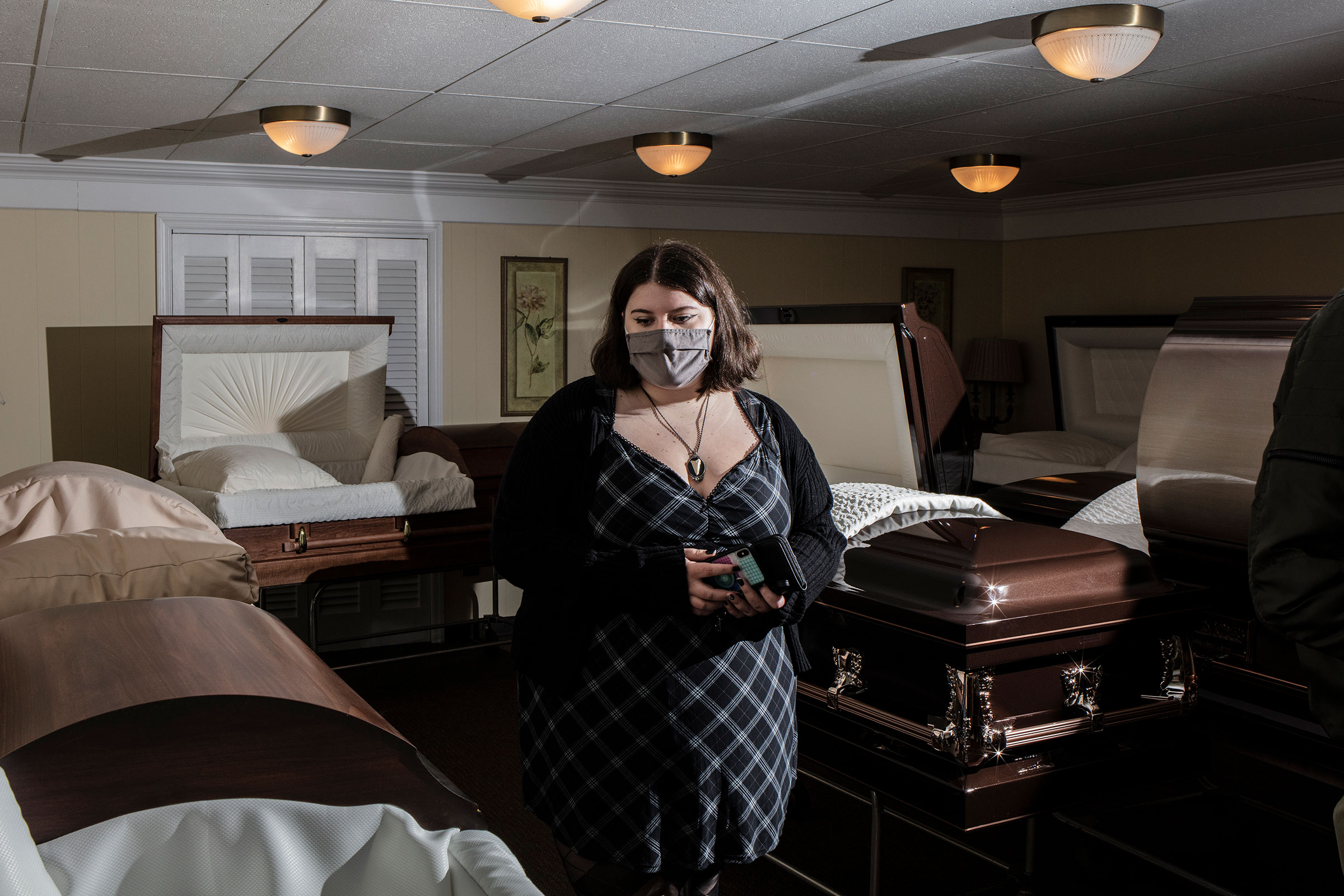Spirits are high as the students file into the basement of the Galante Funeral Home in Union, N.J., to pick out their caskets.
Jessica Polynice, 23, beelines toward the most ornate one in the showroom, joking that she has expensive taste. Others consider the prominently displayed price tags, from $995 to nearly $6,000, and factor in the softness of the pillows. Surrounded by open caskets, Amanda Davis, 20, says she’d rather be cremated into a firework. Beside her, Lauren Duffy, 24, flips through a brochure for artificial reef cremations and weighs whether she’d like to be eternally memorialized on the ocean floor.
The decisions, largely hypothetical, are all part of their next homework assignment to plan their own funerals, presumably for the very far future. They’re among 60 students taking Kean University’s Death in Perspective course this semester, which is one of the many college classes on death and dying in the U.S. that have grown in popularity during the pandemic. And it’s become much more of a grief-support group, professor Norma Bowe says, which is why the field trip to the funeral home starts off lighthearted but ends in tears.
Read more: Death Doulas Used to Be Rare. The COVID-19 Pandemic Changed That
In the last 30 minutes, grief that was well hidden in the funeral home basement pours out of the students in the sitting room upstairs as they share farewell letters they’ve written posthumously to people they’ve lost. “I still feel you at the house,” one student tells her stepfather, who died in 2019 in a suspected suicide. “You’re everywhere there and nowhere at all.” Other letters are addressed to a grandfather whose cancer was caught too late, a 4-year-old cousin killed by a car, a brother lost to drug abuse, an unborn child.

We study dying to know how to live.
“People are coming to this class to lay down their grief,” says Bowe, who gives extra credit to anyone who cries. There’s now a four-year waiting list to enroll in her class. At DePaul University in Chicago, Craig Klugman says there’s been “more buzz” recently about his course on death than in any of the past seven years he’s taught it. And a rise in interest in Duke University’s death-and-dying course has been significant enough that professor Deborah Gold kept teaching it, even though she officially retired earlier that summer. After doubling the number of annual course offerings, Gold still can’t meet the demand.
‘These kids are scared’
Nationwide, students are clamoring to study death from all angles—philosophically, biologically, sociologically, and historically—at ages when most people see themselves as invincible. But it’s not morbid curiosity or grim fatalism at work. Grief is surging among college students, and many are shouldering multiple losses during the pandemic, according to a study published last year in OMEGA–Journal of Death and Dying.
While the most common reported loss was of a sense of normality, the study found that more than 10% of the college students surveyed said a loved one had died of COVID-19. More than 26% said someone close to them had perished for other reasons. In the face of endless death, classes and other experiences that bring death into focus have become an outlet for young people to process their grief, manage their fears of dying, and reckon with their own mortality.
“These kids are scared,” Gold says. “They belong to the age group that believes they are immortal, and all of a sudden it’s not so true anymore.”

For decades, death has been mostly viewed as a taboo subject that most people would rather avoid until it became unavoidable. But young people in the U.S. today can’t escape the fact that from 2019 to 2020, the nation’s life expectancy saw its biggest one-year drop since World War II, mainly because of COVID-19. And after rampaging through older generations, the virus is now affecting younger people in higher numbers than ever before. While death among young people remains low relative to death rates for their elders struck by COVID-19, people ages 18 to 29 now account for the biggest increase in virus cases, according to the latest data from the U.S. Centers for Disease Control and Prevention.
“Seeing so many people my age dying,” Polynice says, “it scares the hell out of me.”
Add to the mix a gloomy forecast for the planet as climate change spawns lethal weather events, as well as iffy career prospects upon graduation, and it’s clear that COVID-19 isn’t the only anxiety crippling young Americans. “This generation of college students—they’re experiencing cumulative losses in a way that really is unprecedented in our lifetime,” says Erica H. Sirrine, the lead author of the grief study and the director of social work at St. Jude Children’s Research Hospital.
Read more: Funeral Costs Are Driving Families Hit by COVID-19 to Desperate Measures
That’s changed the way many people deal with the inevitable. For the first time, according to one survey, people ages 18 to 34 are 16% more likely to have a will than those ages 35 to 54. The younger generation was the most likely to cite COVID-19 as a major reason to plan for death, the survey said. And while people 55 and older are less likely to have a will than in pre-pandemic years, younger Americans are now 63% more likely to have one. “For the first time in a generation, everyone is experiencing the possibility that death may touch their lives—not someday, but now,” says Ann Burns, president of the American College of Trust and Estate Counsel.
Others are looking for answers in rather unlikely places: college classrooms. Kiara Pauli, 21, experienced her first world-shattering death on Dec. 7, 2020, when her 15-year-old brother was fatally shot. “I felt like I was drowning in my anger and confusion,” she says. Her trauma was compounded by the increasing nationwide death toll from COVID-19, which exacerbated her fear of dying. Pauli, who had never had to deal with death, was suddenly surrounded by it.
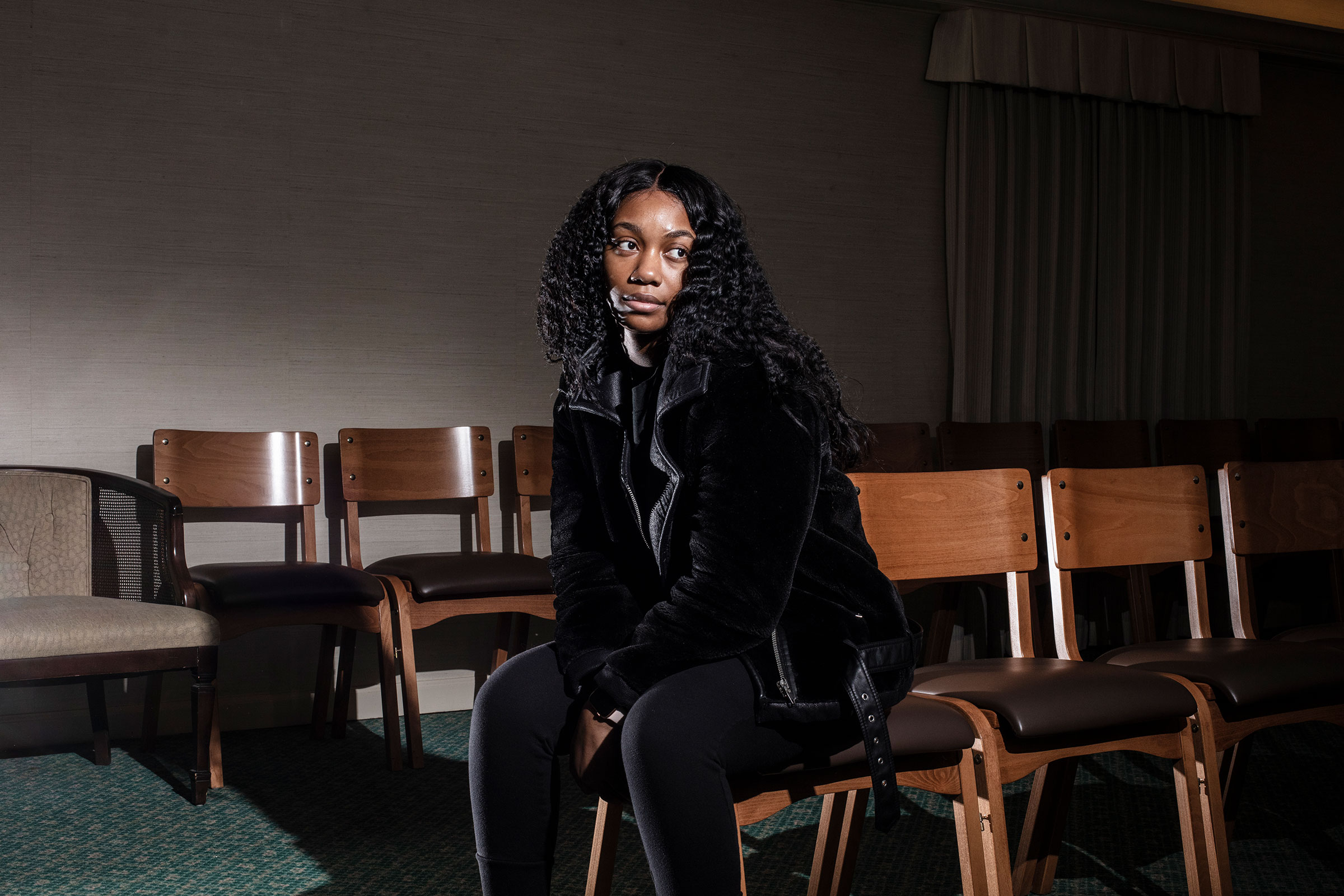
Seeing so many people my age dying, it scares the hell out of me.
In September 2021, she took a death-and-dying class at DePaul—the first time she had forced herself to think about death for a prolonged period of time. Pauli’s perspective changed the first day, when she and about 30 other students watched a video of an elderly man dying, surrounded by loved ones. Klugman, who designed the course, says he uses the video to show what a peaceful death looks like, since most students have never seen someone die. “The first day is about normalizing death and recognizing that at least in the U.S., most people have some anxiety about it,” he says. The video showed Pauli that dying isn’t always terrifying or painful.
Read more: Children and Teenagers Are Being Shot in Record Numbers
One month later, Pauli’s grandfather died following a heart attack. The college junior clung to the lessons she had just learned. She told herself he did not suffer at the end because, thanks to the video of the elderly man, she now had a better understanding of what might happen to someone in their final moments. By the time the course was over in November, Pauli realized she was scared of dying because she didn’t want to be forgotten. She decided to become an author to leave behind a physical legacy.
“We study dying to know how to live,” she says. “The class was like the near-death experience that makes people figure out priorities.”
How death classes fill a role that counseling cannot
In the past two years, college death classes have become one of the most available and affordable options that some students have to deal with their grief. While most U.S. universities offer counseling services to students at little or no additional cost, when campuses closed during the pandemic and learning went remote, tens of thousands of out-of-state students lost access to those services because of differing telehealth guidelines in their home states, says Dr. Ryan Patel, chair-elect of the American College Health Association’s mental-health section. A school psychiatrist or counselor in Ohio, for example, would not be able to virtually counsel, on a routine basis, a student who was home in New York, without a license in the other state.
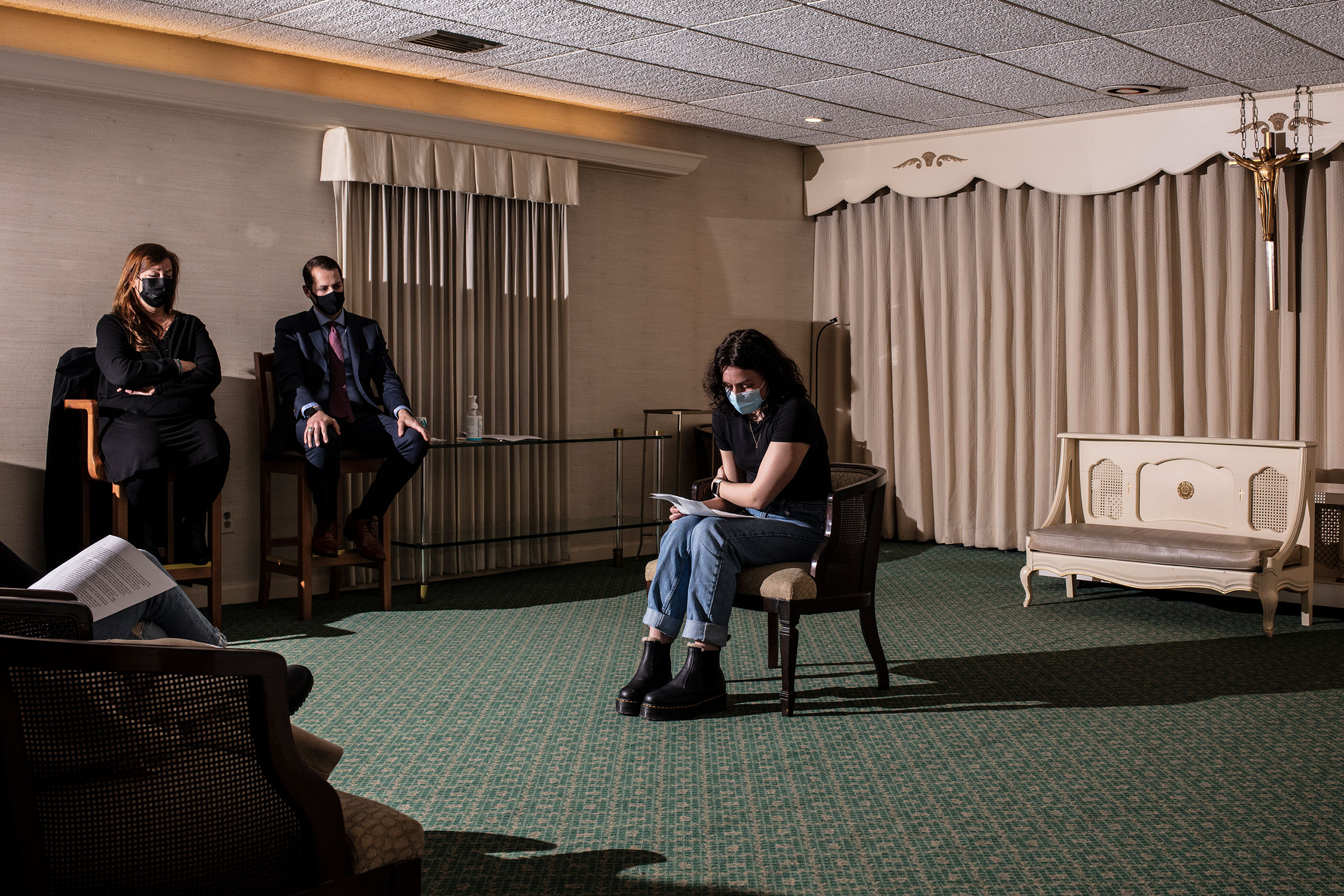
That left few other options for many who were struggling. They could see a therapist or another professional, which could cost $50 to $100 out of pocket for one session, depending on where they live, says Patel, who is also a psychiatrist at Ohio State University. They could also contact several free national crisis help lines. But those providers might not be as specifically trained to understand the unique academic, social, and financial struggles that young students endure as much as campus counselors might, Patel says.
Even those who stayed in-state and maintained access to their college’s counseling services faced hurdles. Some, surrounded by family members at home, lost a sense of privacy to discuss their mental health, while others went back to environments that worsened their mental health. The predicament has only grown more dire amid the rapid-spreading Omicron variant. Patel worries these challenges will continue in the near future.
“A hybrid form of education in some form is here to stay,” he says. “So we’re left with trying to figure out how we are going to provide support services for students.”
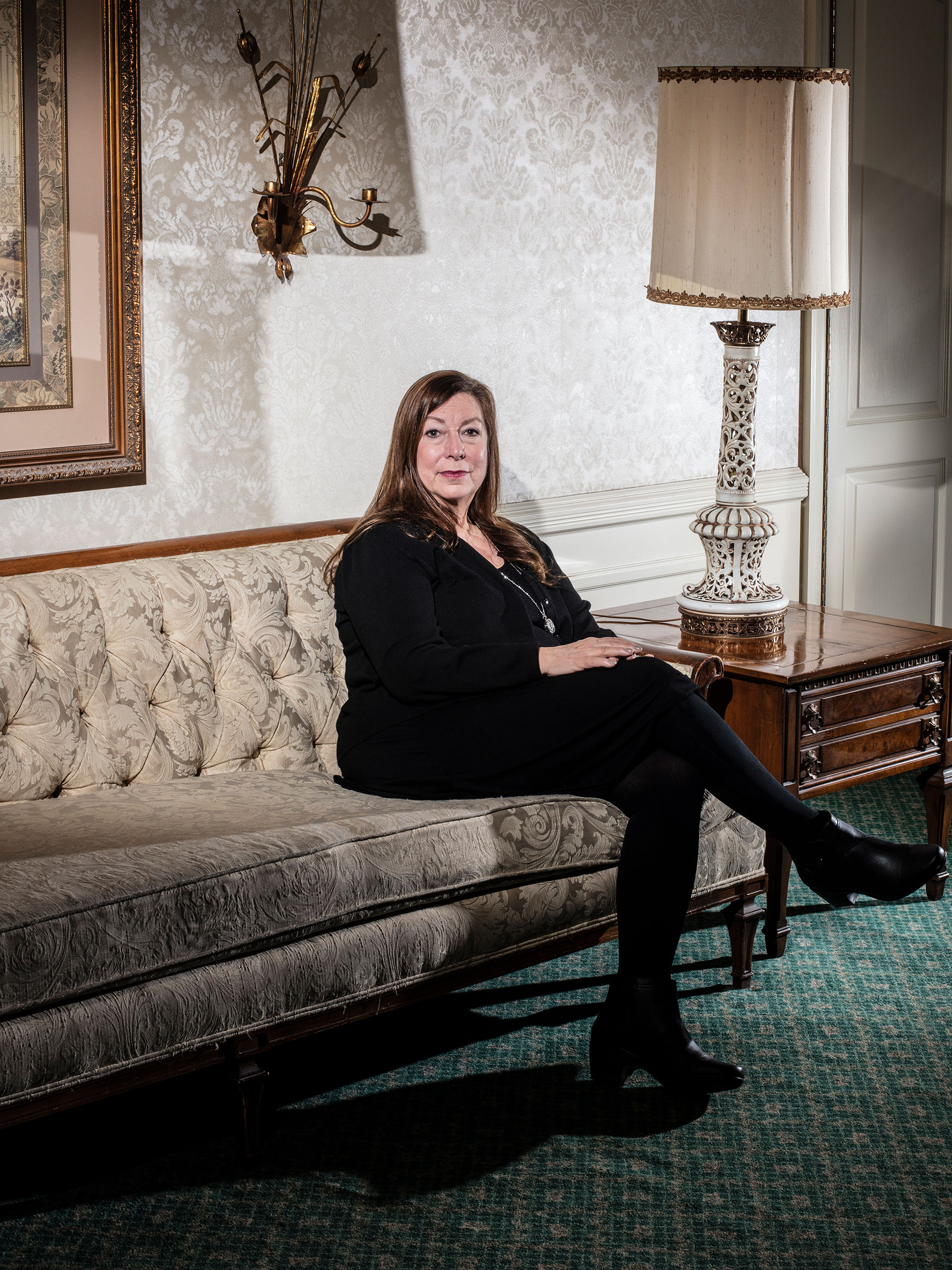
We carry grief like a backpack full of bricks.
College classes on death and dying are not new. Bowe, a registered nurse, has been teaching her course since 1997, and Gold’s class at Duke was first approved in 2001. But their rise in popularity in a pandemic makes sense from a psychological viewpoint, says Coltan Scrivner, a University of Chicago researcher who studies morbid curiosity. In a 2020 study, Scrivner found that people watched horrific things, like scary movies, as a coping mechanism during the pandemic. The study said horror fans and the morbidly curious have been more psychologically resilient as the world changed. “It feels good to control what will terrify you,” Scrivner says.
Some philosophy students may find it easier to cope with death by discussing at length the possibility of an afterlife, or whether the fear of death is rational, says Yale University professor Shelly Kagan. Other students elsewhere appear to be craving concrete, scientific knowledge. At DePaul, Klugman has noticed a new surge in interest from students with questions about infectious diseases. In 2020, he added a new lecture comparing COVID-19 to past pandemics like the 1918 flu, and other mass deaths from major natural disasters.
“What they want to know has changed,” Klugman says. His students frequently ask how to talk to somebody who has lost a loved one and, more specifically, how to talk to someone who has lost a loved one to COVID without getting into a political argument.
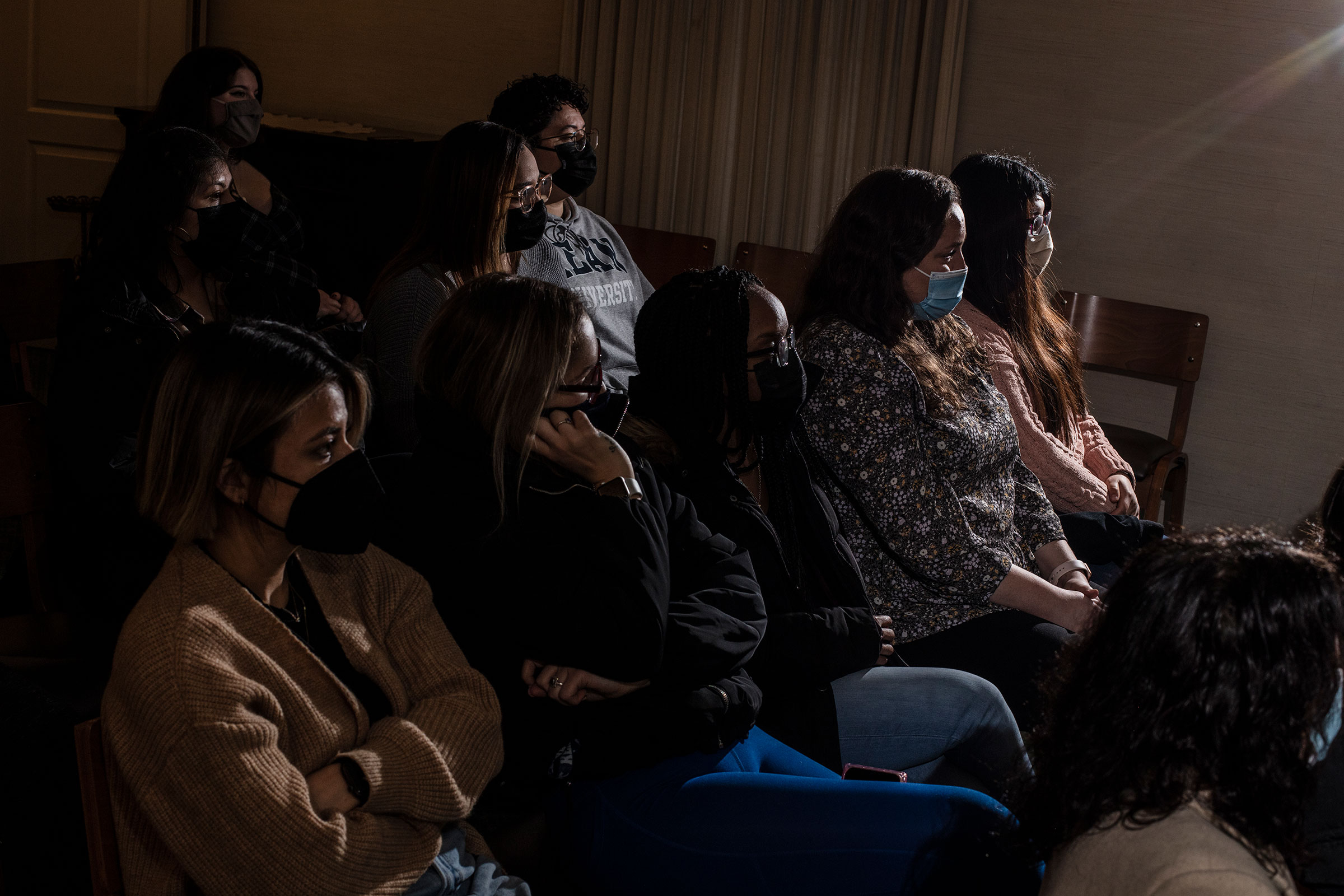
For many, a mental-health necessity
Bowe has seen a similar shift. Three years ago, she’d say her students were drawn to her class for the unique field trips, which got them out of school to watch live autopsies at morgues and roam cemeteries for scavenger hunts in the evenings. Today, those trips are only minor perks, and the class itself has become more of a mental-health necessity. “We carry grief like a backpack full of bricks,” Bowe says. “There’s nowhere to let it go.”
The recent funeral-home trip exposed just that. Many of the students’ wounds were fresh, but several have never healed. Polynice has been suffering in silence for nearly a decade. Her family avoids talking about her grandfather’s traumatic death, so she’s not used to acknowledging the pain she still feels. And while she made jokes as she shopped for caskets, tears welled in her eyes as she revealed she was 14 when her grandfather bled to death in the home they shared. He had accidentally hit a tube kept in his arm for dialysis treatments, Polynice says, adding that she remembers waking up to screams and cries.
“This class makes you uncomfortable,” she says, “but I’m better because I’m able to talk more openly about it.”
Amanda Davis, whose 78-year-old grandfather died over the summer from cancer that spread from his liver to his bones, has gotten the same sense of closure. “No one teaches you how to grieve,” says the sophomore from Sacramento, who is one of the first volunteers to share her farewell letter with the class. “Things remind me of you every day,” she reads out loud, turning bright red as her face mask absorbs the falling tears. But as soon as she’s done, Davis feels instant relief.
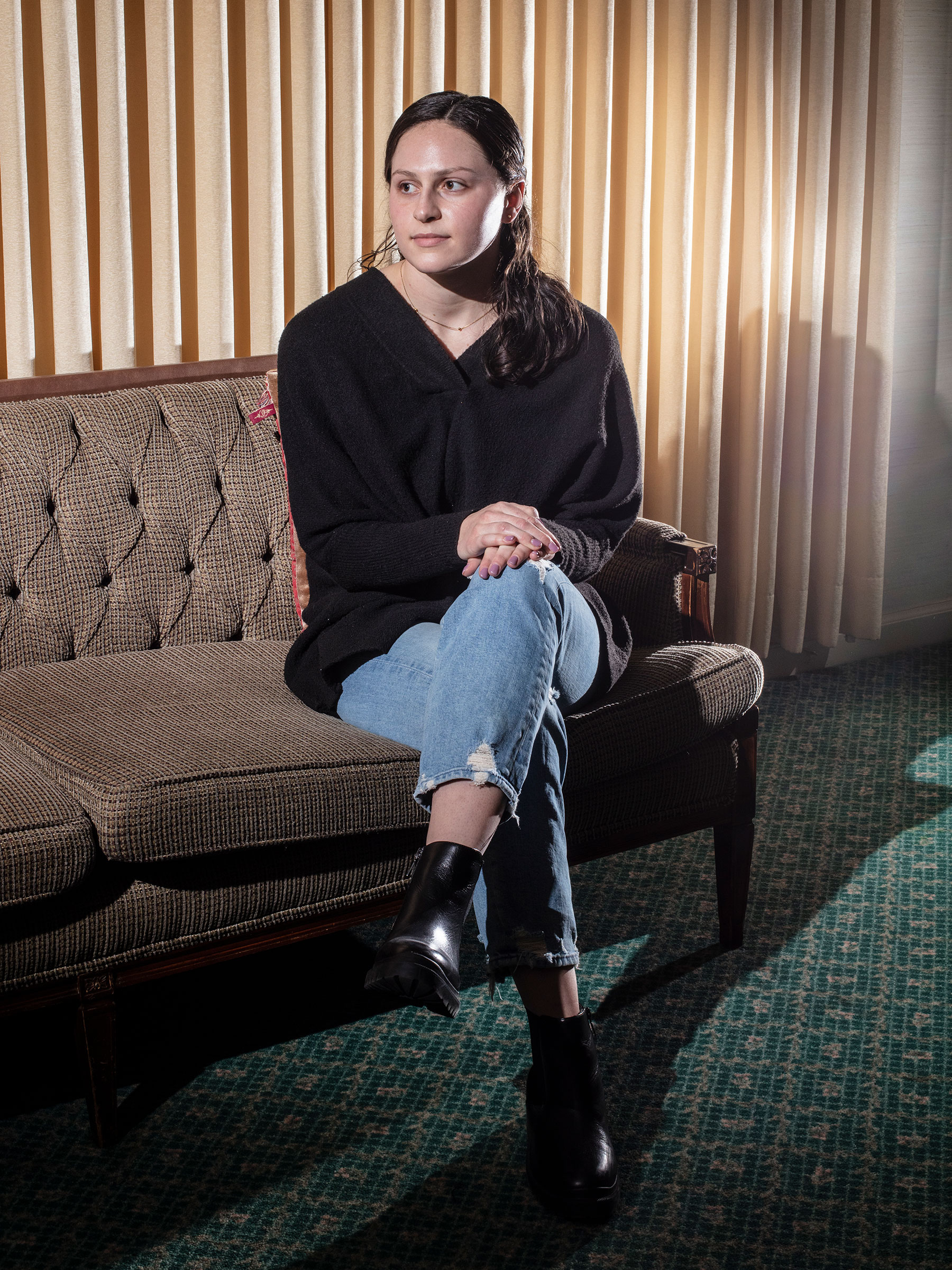
No one teaches you how to grieve.
In the past two years, all 330 students who have taken Bowe’s death class have either lost a loved one to COVID-19, know somebody who has, came close to losing someone to the virus, or almost died from it themselves. The disease took two from Daniela Derius-Rodriguez, just as she was about to complete Bowe’s course. After being put on a ventilator, Derius-Rodriguez’s mother died on April 21, 2020, three weeks after the student’s grandfather had died. At 21, it was the first time she had experienced death. “I was grieving while learning about grieving,” she says.
Bowe said that she didn’t have to finish out the semester, that she had already gotten an A. It didn’t matter to Bowe if Derius-Rodriguez took the final exam, which consists only of reflective questions, because her main goal as a death-class professor is for every student to walk away with a deeper appreciation of life. But Derius-Rodriguez still came to class and handed in every assignment until she graduated that May. Her grandfather and mother had always put an emphasis on education and the importance of working through hardships, so Derius-Rodriguez didn’t want to take the easy way out. But she had also come to rely on her classmates for support, and on the lessons to make sense of how she was feeling.

“I was in a room full of strangers, but I felt so connected to them,” she says. The class kept her from being closed up, and she made sure the rest of her family wasn’t bottling up their pain too. Without the class, she says, “I would have been in the dark.”
At a minimum, death classes get people talking about their pain rather than holding it in, says Sirrine, the grief-study author, who until recently had taught college death classes in Florida for the past 14 years. They also increase empathy at a time of fraught social interactions. “If we can move toward each other and extend more compassion to people who are suffering,” Sirrine says, “then maybe the pandemic won’t be all a loss.”
Two years ago, when Derius-Rodriguez perused caskets at the funeral home for the first time during one of Bowe’s field trips, she crossed her fingers and hoped she’d never have to organize a funeral for real. A month later, she was helping her family plan two. The 23-year-old now understands that grief is inevitable because it’s a by-product of love. “When it does come to us,” she says, “we need to learn how to handle it.”
More Must-Reads from TIME
- Why Trump’s Message Worked on Latino Men
- What Trump’s Win Could Mean for Housing
- The 100 Must-Read Books of 2024
- Sleep Doctors Share the 1 Tip That’s Changed Their Lives
- Column: Let’s Bring Back Romance
- What It’s Like to Have Long COVID As a Kid
- FX’s Say Nothing Is the Must-Watch Political Thriller of 2024
- Merle Bombardieri Is Helping People Make the Baby Decision
Contact us at letters@time.com
